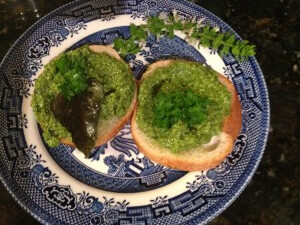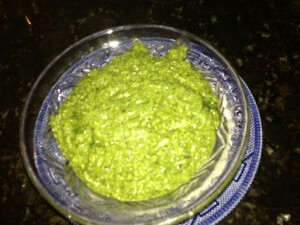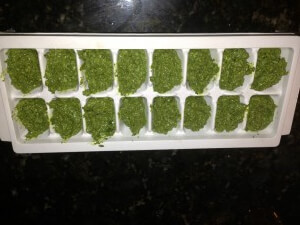
You’ve seeded and nurtured the tender leaves. You’ve added the flavor-packed herb to salads and stirred it into sauces. It’s summertime and I’m talking basil, of course. Sweet, Thai, Purple, all common varieties and easy to grow. And the more you prune, the more this sun loving plant flourishes. But, summer doesn’t last forever and basil loses some of it’s punch once dried, so what to do with all the extra fresh leaves. Why, make pesto of course.
From pasta to Pita bread, this rich aromatic sauce goes well with practically everything. Pesto(Italian; Pestaire) originates from the Genoa region of Northern Italy. Its traditionally made from crushed garlic, olive oil,fresh basil, pine nuts and Parmesan cheese using a mortar and wooden pestle. But, I’m going to show you the down and dirty on how to make pesto in a jiffy.
You will need 3 cups of freshly picked basil, de-stemmed .
2 to 3 cloves of fresh garlic, peeled. More, if you prefer.
1/2 cup good quality Extra Virgin Olive Oil( EVOO)
1/2 cup pine nuts, toasted
3/4 to 1 cup Parmesan cheese. Omit fresh Parmesan if freezing
1/2 cup fresh parsley(optional)
2 tablespoon fresh lemon juice
Salt and freshly ground pepper to taste.
Pack basil leaves into the large capacity bowl of a food processor, along with parsley if using. Top with garlic cloves, toasted pine nuts and Parmesan. Process until all ingredients are finely chopped. Pouring olive oil from the top, add lemon juice and process until smooth paste. Remove lid and salt and pepper to taste.
And presto, you have pesto!

Freezing tips:
If you want to freeze pesto to enjoy at a later date omit the fresh Parmesan. Although, I’ve found the shaker type jar of inexpensive Parmesan freezes well enough. But once thawed, you can easily mix in fresh cheese before serving.
Spoon pesto into ice cube trays and place in freezer overnight. Cover with a sheet of wax paper. The frozen pesto cubes will pop out easily enough the next day. Place in freezer storage bag and label. A plentiful basil harvest will provide a taste of summertime all winter long. Just imagine a creamy pesto sauce over pasta on a cold day. Yum!

Editors note. Pine nuts, especially the European pignolia are 2 to 3 times more expensive as the Asian nuts. The Asian pine nuts have a much milder flavor and are easier to find in larger quantities. However, they have been known to develop a rancid taste if not used up quickly. Toasting before processing helps enhance the nutty flavor. Slivered almonds or pistachios are another alternative.
I’ve made pesto utilizing other leafy, aromatic plants. Swiss Chard, arugula and spinach make great pesto. Experiment with your own pesto recipes and let me know your favorites.